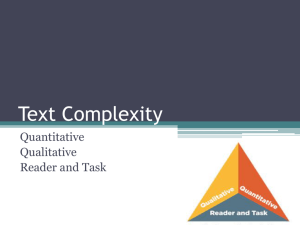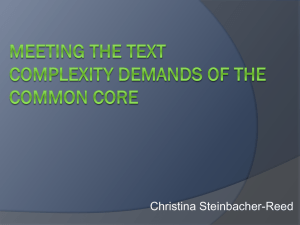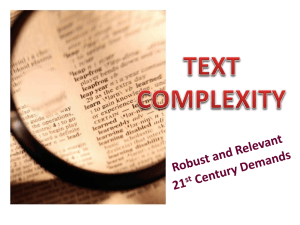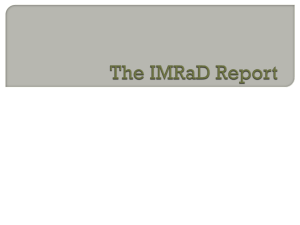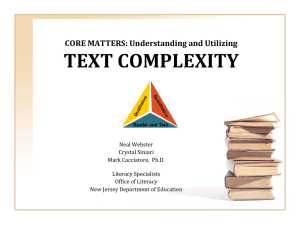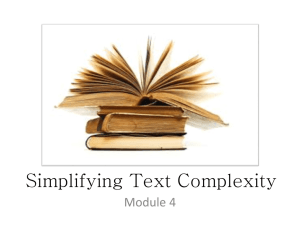Text Complexity
advertisement
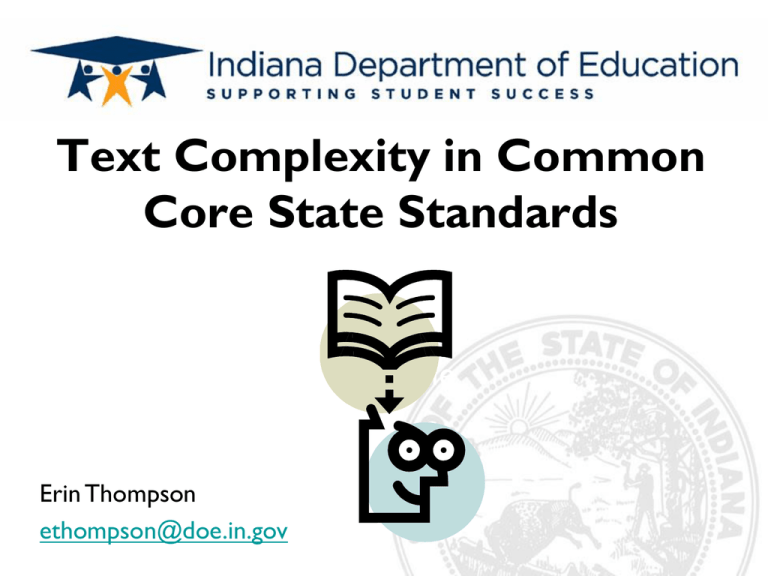
Text Complexity in Common Core State Standards Subtitle Erin Thompson ethompson@doe.in.gov Grade band text complexity What constitutes a complex text? “Complex text is typified by a combination of longer sentences, a higher proportion of less-frequent words, and a greater number and variety of words with multiple meanings.” PARCC Model Content Frameworks Overview of Text Complexity Text complexity is defined by: 1. Qualitative measures- levels of meaning, structure, language conventionality and clarity, and knowledge demands 2. Quantitative measures- word length or frequency, sentence length, and text cohesion 3. Reader and task considerationsmotivation, knowledge, and experiences Qualitative Measures • Qualitative dimensions and factors are those aspects of text complexity only measureable by an attentive reader. Qualitative Elements • Levels of Meaning or Purpose o Is it specifically stated/clear? Or are there inferences that need to be made by the reader? • Structure of Text o Linear/nonlinear, one/multiple narrators, deviations from standard conventions of genre, number of plots • Language Conventionality and Clarity o Literal, clear, or contemporary language vs. figurative, ambiguous, or unfamiliar language • Knowledge Demands o Is understanding dependent on prior knowledge or open to any level? Quantitative Measure • Quantitative dimensions and factors are those aspects that are not easily measureable by a human and are typically measured by programs such as Lexile. * New text complexity tools for Common Core will be available in Fall 2014. CCSS does not endorse any particular quantitative measures. They only suggest using multiple measures to determine text complexity. Various Quantitative Measures • Flesch-Kincaid Grade Level test –uses word length and sentence length • Dale-Chall Readability Formula and Lexile Framwork for Reading- substitutes word frequency instead of word length • ATOS formula (Accelerated Reader)- uses word length, sentence length, and text length Realigned Levels- Adjusted Upward Which one do we use? • The immediate recommendation from CCSS is to select texts that are within the appropriate band of complexity using currently available (multiple when possible) quantitative measures, and then make keener distinctions using a blend of qualitative measures. Reader and Task Considerations • Reader and task considerations must also be made when determining a text’s appropriateness. Readers and Tasks • Factors such as motivation, knowledge, and experiences are important to consider when selecting a text. • The purpose of the reading also needs to be considered. “The use of qualitative and quantitative measures to assess text complexity is balanced in the Standards’ model by the expectation that educators will employ professional judgment to match texts to particular students and tasks.” Appendix A All students should have access to complex texts • Students who are not reading at grade level should have access to complex texts with appropriate scaffolding and support. • Even many students who are reading at grade level may need scaffolding as they master higher levels within the text complexity band. To help students access more complex text. . . • Read some shorter texts more closely and repeatedly Example Lesson • A Close Reading of Lincoln’s Gettysburg Address: o A short, important historical document o Determined to be appropriate for 9-10 text complexity band o Designed to be taught over 3 class sessions o The lesson includes reading, vocabulary, discussion, and writing tasks http://engageny.org/resource/curriculum-exemplars/ Use the Appendices as a Guide • Appendix A discusses the text complexity expectations for CCSS and provides sample annotated reading texts • Appendix B provides text exemplars and sample performance tasks for literary and informational tasks Shift in Instruction “. . . it is important to recognize that scaffolding often is entirely appropriate. The expectation that scaffolding will occur with particularly challenging texts is built into the Standards’ grade-by-grade text complexity expectations, for example. The general movement, however, should be toward decreasing scaffolding and increasing independence both within and across the text complexity bands defined in the standards.” Appendix A ELA Common Core Resources Resource Link IDOE Resources for PARCC and Implementing the Common Core State Standards http://www.doe.in.gov/achievement/assessm ent/partnership-assessment-readinesscollege-and-careers-parcc http://www.doe.in.gov/achievement/curricul um/resources-implementing-common-corestate-standards PARCC website (contains Model Content Framework) http://parcconline.org/ Common Core State Standards (official website) http://corestandards.org/ Common Core resources from New York http://engageny.org/common-core/ Short Text Complexity Video from Timothy Shanahan http://www.youtube.com/watch?v=b5uhmwsD6Y Sources Appendix A: Research Supporting Key Elements of the Standards, Appendix B: Text Exemplars and Sample Performance Tasks http://dc.doe.in.gov/Standards/AcademicStandards/PrintLibrary/co mmonCoreEnglish.shtml David Coleman Presentations: Bringing the Common Core to Life http://vimeo.com/25206110, CC in ELA/Literacy http://engageny.org/resource/common-core-in-ela-literacy-anoverview/ PARCC Model Content Frameworks for ELA/Literacy http://parcconline.org/parcc-content-frameworks Questions?


